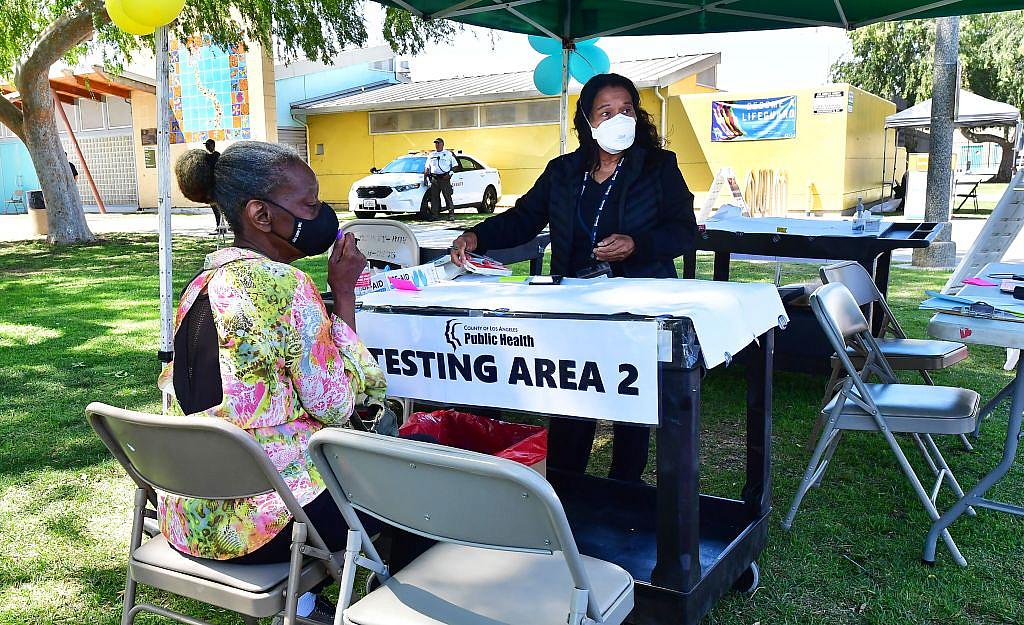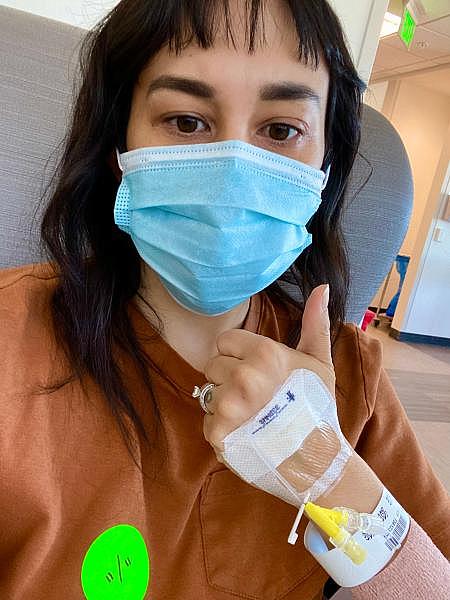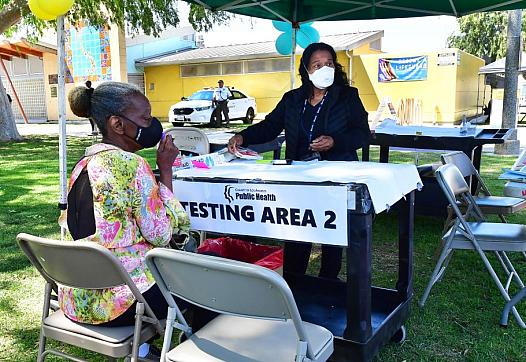People of color with long COVID face uphill battle to be heard
This story was originally published in Scientific American with support from the USC Annenberg Center for Health Journalism’s 2022 California Fellowship.

(Photo by Frederic J. Brown/AFP via Getty Images)
In March 2020, when Los Angeles residents began sheltering in place amid the COVID pandemic, Angela Vázquez and her husband went out shopping for some essentials. A few days later they both experienced mild COVID symptoms: low-grade fever, upset stomach, fatigue, headaches, chills, loss of sense of smell—nothing serious enough for a doctor to order confirmation tests, which were being rationed at the time.
But in the weeks and months after she was finally diagnosed with COVID a few days later, Vázquez’s condition worsened. She began experiencing what she describes as strokelike symptoms, including severe confusion, and found it difficult to walk or keep her balance.
“I visited the ER several times in one week and was told each time that it was impossible for COVID symptoms to last this long,” says Vázquez, now age 35. Once, she adds, she was discharged with having “shortness of breath.” She felt like she was being told it was all in her head.
The sequelae (or long-lasting symptoms) triggered by a temporary infection with the COVID-causing virus SARS-CoV-2 can last for months or years—a condition that has come to be termed long COVID. The constellation of reported debilitating symptoms can involve nearly every organ system. Its pathology often includes cognitive impairment (“brain fog”) and relentless fatigue that worsens after even minor physical or mental exertion.
Having a debilitating condition that still baffles medical science can be nightmarish for anyone. But Vázquez says her youth, gender and ethnicity made it particularly difficult for her to convince doctors her symptoms were real. “I was seeing largely white male doctors, and a young Latina presenting to the emergency room made it very easy to psychopathologize my symptoms and dismiss me,” she says.
Today Vázquez is president of Body Politic, an organization that advocates for people with long COVID and offers them an online support group. Many of these individuals, Vázquez says, have similar stories of battling a confusing new condition while navigating an ill-equipped bureaucracy as a person of color. She describes the spread of long COVID as a “mass disabling” event. And “we absolutely know that COVID-19 has disproportionately impacted communities of color and immigrant communities,” she says. “But they’re not showing up in our clinics in primary care for a variety of reasons, such as systemic poor access to health care.”
Ashley Jackson, a California-based actress, screenwriter and producer, recounts a related experience. She says she caught what was likely COVID in January 2020 (before testing was available) and that her doctors told her she should be fine after two weeks. But her symptoms never left.
“By the eighth week, I was like, ‘Something is wrong,’” says Jackson, who is now 23 years old. She eventually caught COVID again in April 2020, this time confirmed by a test, and for a short while lost her ability to breathe easily. Again, Jackson says, her doctors dismissed her concerns. “After about two weeks, they’re like, ‘You should be fine. You’re testing negative now,’” she adds. “And I basically just never recovered.”
Jackson—who caught COVID a third time earlier this year—says she has had constant headaches that turn into migraines, as well as shortness of breath and an elevated heart rate. And she has since developed fibromyalgia and Graves’ disease, an autoimmune condition that causes hyperthyroidism. “From beginning to end, my body is just still in shambles,” she says. “Mind you, prior to all of this, I was 100 percent healthy.”

Jackson eventually joined Body Politic, which she says helped her understand what she was going through and kept her from giving up. She says she is now being treated at the UCLA Health Long COVID Program in Los Angeles. It took her a long time and a lot of effort to find doctors who actually understood her condition, however. “I think being a Black woman being seen in any medical space, there’s still historic gaslighting going on. Our pain is dismissed oftentimes in medical spaces,” Jackson says.
Samantha Artiga, vice president and director of the Racial Equity and Health Policy Program at Kaiser Family Foundation, co-authored a report earlier this year noting how people of color have borne the overall brunt of the pandemic in multiple ways, such as being at higher risk for infection, illness and death. How that translates to long COVID outcomes is not entirely clear, but many think the answer will further demonstrate yet another racial disparity among many in American health care—one that has received relatively little attention.
“There’s not a lot of data to understand who’s being affected and how,” Artiga says. Data on about 88 million cases collected by the U.S. Centers for Disease Control and Prevention only included race or ethnicity data 65 percent of the time. A 2021 review of studies characterizing long COVID found that just six out of 39 studies, or 15 percent, included ethnicity data.
“To the extent that people are dealing with long COVID, people of color are going to face the same inequities they face in terms of accessing health care generally, in terms of potential treatments for long COVID,” Artiga says. But without good data in this area, it can be difficult to know more precisely whom to reach out to in attempt to help—and how.
The CDC estimates that one in 13 American adults now has long COVID, defined as symptoms lasting longer than three months after one first contracted SARS-CoV-2. Citing data from the Household Pulse Survey, which the Census Bureau began collecting in collaboration with the National Center for Health Statistics and several other federal agencies in April 2020, the CDC says that between late July and early August, 9.2 percent of Hispanic or Latino adults reported they currently had long COVID, while 7.4 percent of white adults and 5.4 percent of Black adults did so. Asian adults came in at 4.6 percent.
Unfortunately, these are some of the only data that currently exist in this area, and they don’t tell much about who is—or isn’t—receiving adequate or appropriate long COVID treatment. Officials may finally be acknowledging the problem, albeit with some steps that still seem tentative. On April 5 President Joe Biden issued a “Memorandum on Addressing the Long-Term Effects of COVID-19” as part of the White House’s “efforts to prevent, detect, and treat” long COVID. In it, he pledged to “advance our understanding of the health and socioeconomic burdens on individuals affected by long COVID, including among different race and ethnicity groups.”
More recently the administration released two Department of Health and Human Services reports on long COVID—one that details services and support for treating the condition and another that outlines strategies for conducting research. But while touching on the issue, neither report goes into great detail about racial disparities or specifics on how to address these barriers, which can include poor access to resources for long COVID or inadequate health insurance coverage.
“While racial disparities in Long COVID are relatively unexplored, it is well understood that some racial and ethnic minority communities are disproportionately impacted by COVID-19,” states one of the reports, The National Research Action Plan on Long COVID.Both reports were released in early August.
In December 2020, Congress provided the National Institutes of Health with $1.15 billion over four years to study long COVID. The project, called RECOVER (Researching COVID to Enhance Recovery), launched in February 2021. It involves “more than 100 researchers who are leading studies on Long COVID at more than 200 places around the country,” according to its website.
So far RECOVER has recruited around 8,600 adults with prior COVID infection—a number somewhat lower than the program’s stated goal of enrolling 17,680 long COVID patients. Demographic background material provided by Catherine Freeland, RECOVER’S communications and engagement program director, reported that study participants are 16 percent Black, 7 percent Asian, 3 percent Native American or Alaska Native, 15 percent Hispanic, 0.5 percent Native Hawaiian or other Pacific Islander and 63 percent white.
Along with a dearth of data on who is diagnosed with long COVID, there is also little information on those receiving treatment. “We know that people of color are less likely to have health insurance coverage, which translates into increased barriers to accessing health care,” Artiga says. “There is also really limited data available to date in terms of how COVID-19 treatments are being distributed and who’s receiving them.”
A study published in July poured through more than 400,000 lab-confirmed COVID cases in a database of more than 50 U.S. health care organizations assembled by TriNetX, a privately run network of such organizations around the world. The researchers identified 8,724 cases where people sought outpatient rehabilitation, which many experts recommend to help treat long COVID.
Despite adjusting for severity of symptoms, age, sex and comorbidities, the study found that of those seeking outpatient rehabilitation, Black patients had significantly lower rates of using such services than those of any other race. “Racial differences in outpatient rehabilitation use and potentially unmet needs during recovery may further exacerbate the disproportionate harm COVID-19 has wrought on African American/Black individuals and communities in the United States,” the study authors wrote.
“Sometimes not seeing a group of people in your clinic might be a disparity,” says Giv Heidari-Bateni, a cardiologist who works at Loma Linda University Health’s COVID-19 Heart Clinic. Heidari-Bateni says he has personally seen disproportionately more Hispanic patients than white ones—but far fewer Black patients than either. “Does that mean that they’re more prone to this, or not coming to my clinic means they have less access to this care?” Heidari-Bateni wonders. Without additional data, it’s difficult for him to say. He also notes that a lack of public information may play a role in potential disparities.
“Long COVID is still a new term, and a lot of my patients are not familiar with this entity,” Heidari-Bateni explains. “People may, for example, have [heart] palpitations. They may not know that these palpitations can be because of the COVID they just acquired. So now the question is ‘Do we have education freely and easily available for every people?’ Probably the answer is no.”
The California Department of Public Health (CDPH) has been collecting data on long COVID but has encountered a lack of “studies that adequately examine the impact upon communities of color,” a CDPH spokesperson wrote in an e-mail to Scientific American. “We hope to be able to characterize differences in how communities are impacted by long COVID.”
The spokesperson also wrote that CDPH has partnered with more than 200 community-based organizations to deliver “key messages in a culturally relevant” manner via ad campaigns, webinars, web pages, social media platforms such as Twitter and Instagram, multilingual handouts—even a WhatsApp chatbot in Spanish and English. When texted about long COVID, that bot returns a link to California’s long COVID information portal, which includes videos in both languages.
“I think we still have a lot of work to do to identify what our burden of long COVID is,” says Jennifer Chevinsky, a physician who was one of the first to recognize long COVID as a chronic condition during her time as an Epidemic Intelligence Service officer at the CDC. Using feedback from Body Politic and other long COVID support groups, including Survivor Corps and the Patient-Led Research Collaborative, Chevinsky wrote the CDC’s interim guidance for health care providers evaluating and caring for patients with post-COVID conditions.
Chevinsky is currently a deputy public health officer at Riverside University Health System–Public Health, which serves Riverside County, California. There she has worked to prioritize the issue of possible racial inequities in the state’s long COVID response. This has involved tens of thousands of follow-up calls to learn about patient experiences after testing COVID-positive, teaching implicit bias courses to local health care providers and hosting training sessions on long COVID for “promotores”—community health workers serving the Latino population, including migrant and agricultural workers.
“How long COVID impacts different people across different demographic groups is an area that we need to develop more. We’re likely to see disparities, so we can react on that,” Chevinsky says. “It continues to be a fight. We need more resources, and we need more funding. And we’re working to try and improve the services that are here. But there’s still work to be done.”

